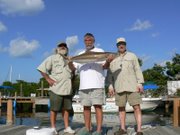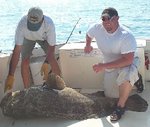Fishing the Florida Keys - Sailfish Basics
Fishing for sailfish is a pretty big thing this time of year in the Florida Keys. Sails normally run November through April. The peak time will vary some each year and some years are much better than others. It is still pretty much world class fishing every year. A charter having four to six shots a day is a good average. Most of the sailfish are caught on live bait, Pilchards, ballyhoo, goggle eyes and other, in that order. Dead bait trolling and lures will produce, but not as well as the live bait.
More and more captains employ drift fishing with live chumming as their preferred method. Kite fishing is used by a few, but isn’t very effective if you have not found the fish. I prefer to mix it up, running and gunning a while to locate bait and sails, then live baitfish for them. Sight casting to the fish is really what I like once the fish are found, but drifting in a good area loaded with bait is what happens most of the time.
While a bait tank full of Pilchards or ballyhoo is preferred, sometimes you have to go with what you have. Blue runners, pinfish, yellowtail snapper and even needlefish have produced sails for me.
Rigging for sails is pretty much like rigging for tarpon. On the spinners I have 5 to 8 feet of double line and 6 to 8 feet of monofilament leader. Normally fifty to sixty pound leader is all I use and I fluorocarbon is a big deal with me. The hook is a 5/0 to 7/0 J or a 6/0 to 9/0 new type circle; it depends on my mate and my customers. With Pilchards or any live bait other than ballyhoo, just hook them in the nostrils. With ballyhoo, I hook them in the upper lip and us a short piece of copper rigging wire to wrap the bill and hook shank. Blue runners are tough to fish because at the first sign of a sail they try to climb back in the live well. This means I will use a balloon about six in front of the blue runners. This make them look a little more stupid and I can keep an eye on them. Having a bait look stupid isn’t a bad thing. Darwin’s survival of the fittest theory explains the reason. Stupid or defective critters are removed from the gene pool quickly.
For conventional rods, I use the wind on leader setup described in the six basic knot posting. I use the conventional a lot of the time when I have rookie anglers and no mate. I the anglers how to let the bait on the conventional tackle out and drive the boat in front of the fish. This also works on regular drift fishing. I really like having my customers fight big sails on light spinning outfits. Catching an 80-pound sail on ten or twelve pound test is a hoot that you can brag about later. The tournament guys use 30 pound on their spinners and thirty to fifty pound on their conventional rods to rack up numbers. That’s fine, I know how to do that too, I just prefer the light tackle and the shorter leaders. Who was it that said its not destination, it’s the journey. That’s fishing and me.
Finding the fish for me is the fun part for me. I’m looking for birds working, bait sprays, black trash bags in the water (that’s what a sailfish looks like swimming in the water) and free jumpers. Free jumping sails are neat to see, but you rarely get one in your lines. That said you have to check them out anyway. Come on! You got a shot right!
Best depths to hunt for sailfish in the winter is 100 to 300 feet. They can be on the reef or all the way past the ledge. Whether you need to run to alligator light or the Sambos is your guess. I normally work from Bonefish towers to Bahai Honda. Well, once I ran to American shoal and did pretty well. It’s all fishing and sailfish are a very worthy adversary. If you have never tried it, get off your dead butt and give it a go!
Tight lines,
Capt. Dallas






No comments:
Post a Comment